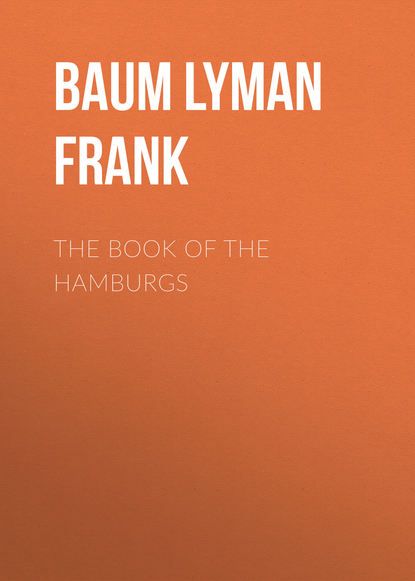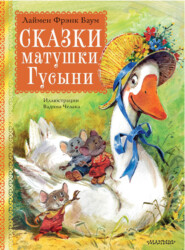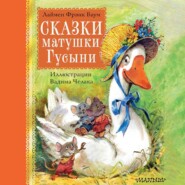По всем вопросам обращайтесь на: info@litportal.ru
(©) 2003-2025.
✖
The Book of the Hamburgs
Настройки чтения
Размер шрифта
Высота строк
Поля
Lyman Baum
L. Frank Baum
The Book of the Hamburgs A Brief Treatise upon the Mating, Rearing and Management of the Different Varieties of Hamburgs
Long before what we now call “fancy fowls” were known or recognized (in fact, long before the memory of any person now living), Hamburgs were kept and bred to feather among the peasants of Yorkshire and Lancashire in England, and by them exhibited at the small town and county fairs in their neighborhood. Of course they were then known under different names, the Blacks being called “Black Pheasant Fowls” and the Spangled varieties “Lancashire Mooneys” and “Yorkshire Pheasants”; while such a variety as the Penciled Hamburgs were either wholly unknown or else were so little thought of that they have left no record of their origin, if, indeed, they are natives of England at all.
EARLY HISTORY
Mr. Wright, who has traced these fowls back still further, inclines to the belief that at some period whereof we have no knowledge the Penciled varieties formed a part of the Hamburg family, although our earliest positive knowledge traces them to direct importations from Holland, where they were brought in great numbers, and were originally known under the names of “Dutch Everyday Layers” or “Dutch Everlasting Layers.”
As such a thing as a black or spangled variety of this fowl was utterly unknown in Holland, it is presumable that at some period the penciled varieties were exported to Holland and there bred and cherished, while they were allowed to run out or sink into insignificance in England. We cling to this belief so tenaciously on account of the wonderful similitude which marks the characteristics of the Hamburg family, in spite of the fact that one branch came from Holland and the other is emphatically English. These two branches, namely, the Penciled and the Spangles and Blacks, resemble no other varieties of fowls in the slightest degree, while their common characteristics are the absence of the incubating instinct, clean, slender legs, neat rose combs, small, round and white ear-lobes, and the light, but sweeping and graceful, lines of form which are wholly their own and unapproachable by any other breed of fowls, no matter how fine their symmetry. If this were not enough to stamp them with certainty of having one origin, we mark the fact that spangled chickens are frequently penciled in their first feathers; while, as they mature, the black spangles or moons are often surmounted by a light tip beyond them, thus again approaching the penciled character, while conversely it will be found that if penciled birds be bred too dark the last bar has a strong tendency to become too wide, thus approaching a spangled character.
If we consider the utter want of interest with which poultry was regarded in the earlier days, and the fact that no traditions of any account relating to fowls have been handed down, we may be justified in believing that these facts prove our conjectures in regard to the original identity of these varieties to be correct. From whence their common progenitor came, we can have no idea, but that they did have one we strongly believe. It may have been that they came from the Blacks, as that variety is thought to be the oldest, and a cross might have resulted in the broken color, or possibly these Blacks having a number of white feathers may have been bred together until a distinctly-marked plumage had been obtained.
Bearing in mind, however, that Aldrovandus speaks of a fowl which strongly resembles the penciled variety as Gallina Turcica, it is possible that the Penciled was the original variety, and, as the name suggests, of Eastern origin.
These conjectures and hypotheses are perplexing and unsatisfactory, and are really of no practical value, being only of use in affording another instance of the fascinating problems which constantly present themselves to the poultry fancier of a philosophical and inquiring turn of mind. This much appears to be certain: that of all our many varieties of fancy fowls the Hamburg is by odds the oldest; indeed, Mr. Wingfield claims that old records show that fowls with all the Hamburg characteristics were bred in the yards of monasteries as early as the fourteenth century.
At the great Birmingham show the authorities there, recognizing the general resemblance between the Penciled, Spangled and Black varieties, and the inconvenience of their numerous and varied appellations, grouped them together under the general name of Hamburgs, by which they have been known since, fanciers accepting with alacrity a name which was at once convenient in classing the breeds and which brought the separated members of what was no doubt a distinct family together, as it is most certain they belong and should be arranged.
Many breeders who have no knowledge of the deliberations at Birmingham have been puzzled to guess why the name Hamburg should have been chosen to designate a family which was mainly English, but these “fathers of the fraternity” had too much business to transact to allow them to inquire very carefully into the early history of this fowl. The Rev. E. S. Dixon proposed “that as the penciled varieties were then imported by the Levant merchants from the port of Hamburg they should all take the general name of Hamburgs,” and, indeed, this term is as euphonious and convenient as any other could be.
CHARACTERISTICS OF HAMBURGS
In usefulness and beauty the Hamburgs stand very prominently amongst that numerous collection of fowls which our broad nomenclature denominates “fancy poultry.” The plumage of every variety, either Penciled or Spangled, Silver, Golden or Black, is at once beautiful and striking, attracting the attention of strangers to the poultry yard or exhibition room when all other breeds have failed to interest them, and drawing from them involuntary tributes of admiration. And if they are so much admired by cold and superficial observers, surely the Hamburg fancier may be pardoned for his unbounded enthusiasm for his favorites when every season and nearly every day unfolds new beauties in his birds and renders them more fascinating and delightful to his eye. The exquisite symmetry, the novel and shapely rose combs, the snowy and delicate ear-lobes, the tapering blue legs and graceful carriage give them an aristocratic and “dressed up” appearance and render them the most beautiful of our domestic fowls.
The Hamburg fancier has plenty of scope in which to indulge his taste, the different colors and markings affording an ample variety from which to choose, while the general characteristics are the same.
“Hamburgs,” says Mr. Beldon in Lewis Wright’s poultry book, “are without doubt the most beautiful breed of poultry we possess, as well as the most useful, all varieties being alike elegant and beautiful. The dweller in the country will generally prefer the Silver, while the citizen will take the Golden or Black; but all of them, in their matchless variety of marking and color, will delight the eye with the utmost degree which is perhaps possible of beauty in fowls. Their marvelous beauty, however, would not recommend the Hamburgs to the practical breeder so much as their wonderful egg-producing qualities, which it has been claimed surpass those of any other breed. The wonderful stories told of Hamburg productiveness, while often more amusing than reliable, serve to show that in any hands, in any climate and under the most adverse circumstances they have proved very profitable to their owners, while with ordinary care they are the best of layers.”
The average Hamburg pullet will begin laying at four or five months of age, and will lay from 150 to 200 eggs the first year under favorable circumstances. The second and third years hens will average from 175 to 225 eggs when properly cared for, and from the third year their productiveness gradually declines, although one reliable breeder asserts that he once owned a Black Hamburg hen which at five years of age laid 220 eggs in ten months. A great deal depends upon the strain of birds and the care they receive, as if productive traits are cherished and carefully bred for, the number of eggs may be greatly increased, while neglect to properly cultivate this quality by careless and incompetent breeders will result in a marked decrease in productiveness.
The absence of the incubating instinct has much to do with the productiveness for which Hamburgs are noted, as no time is lost in sitting or brooding the chicks. Some breeders claim that Hamburgs never attempt to sit. This is incorrect. We have known cases, although we acknowledge they are rare, where Hamburg hens have hatched and reared goodly broods of chickens, in every case proving themselves steady sitters and excellent mothers; nor was there a particle of tainted blood in their veins, these being merely cases where that wonderful instinct which is common to nearly all fowls will “crop out” occasionally in every variety of non-sitting fowls. It is not necessarily due to a former cross, but may be occasioned by “reversion” to which we attribute everything that we do not understand in nature’s domain.
This non-sitting instinct is of double value to the Hamburgs, as they do not lose half their feathers during incubation, but maintain their sleek appearance through the entire season, and when they do moult they moult easily and rapidly, seldom or never being left for a time denuded of feathers, as are most other breeds, but the new feathers making their appearance as the old ones drop out, so that they are never an eyesore to their owners. Indeed, they seem to change their coats so easily that it is no rare thing for hens to lay as steadily during this ordinarily trying process as at any other time. They should, however, have an extra allowance of feed at this time, and a little tincture of iron in their drinking water or a few rusty nails placed in the drinking pans will strengthen and tone up their systems.
To do their best, Hamburgs should have free range. Mr. Beldon, though greatly overdrawing their need for this luxury, attaches so much importance to it that he says: “They are of little use penned up, in which state they pine and mope for liberty; that bright cheerfulness which is common to them disappears, and from being the happiest they become the most wretched of birds.”
Though Mr. Beldon may have found this the case, our own experience has been that no small breeds of fowls will stand the tedium of a long and severe winter in close quarters better than the Hamburgs. In fact, all you need is to keep them busy, and they will seem happy and contented. Still, the larger the grass run they have in summer the greater their productiveness and the better they will do. They are very small eaters, and when at liberty are excellent foragers, being up at break of day and away rummaging the fields and pastures in search of food. Their quick eye at once espies their prey, and “woe to the poor worm that happens on that particular morning to have got up a little too early.” Every corner is searched with indefatigable zeal, and by the time the man gets around in the morning to feed them they have made a good breakfast and are ready for the business of the day. Perfect liberty or a large grass run are valuable adjuncts to health and egg production. Give it them if you possibly can.
As a rule Hamburgs are a healthy breed, being little subject to the common ailments of poultry. One of our correspondents writes: “They are remarkably hardy, often enduring hardships that to other breeds mean disease and death with successful fortitude. I have had young Hamburg chicks pecked by the mother of a rival flock and virtually ‘scalped’ in her insane jealousy, the skin being torn from the head down the entire back, and yet the youngster would trot around as lively as though nothing had happened, and not only get well but flourish. Sometimes the feathers would grow out upon the ‘skinned’ place, and sometimes it would always retain a smooth appearance. I have now a hen, which we consider one of our best breeders, without a vestige of feathering upon her entire back, owing to a like accident in her youth. The chicks are very easily reared. Of course they must have proper care, as they cannot rear themselves; but with a moderate degree of attention no trouble will be found in raising them to maturity.
“Taken as a whole we consider the Hamburgs as hardly excelled by any other fowl for the farmer, fancier or poulterer. On a good homestead they will keep themselves, and if well attended to will pay better than any other farm stock in proportion to the investment. In fine, I feel perfectly safe in an assertion that in no one breed will be found so much beauty and usefulness, and so many excellent qualities, as in the several varieties of the Hamburg family, while in the one item of egg production they stand to-day where they did hundreds of years ago, unrivaled by any domestic fowl.”
This is a statement of one who is full of enthusiasm, but it may be noted that only a superior breed of fowls would excite so much commendation in a breeder who has been familiar with them from his youth.
BLACK HAMBURGS
Although there is no certainty that this is the oldest variety of fowls, still, as it has a pedigree of nearly 200 years, it is presumable that it was the oldest variety of the Hamburg family. Mr. Beldon considers the claims of the Spangles and Blacks to be about equal as regards age, and rather favors the former. However, a passage in an old book published in London in 1702 by Thomas Sutlief, entitled “A trip to the North of England,” has induced us to believe that the Blacks were the oldest breed. It says: “One of my pleasant reminiscences of this county (Lancaster) is the pleasure with which I regarded their pretty fowl, the Black Pheasants, as they call them, and which furnished me many a delicious fresh egg for my breakfast… The stout peasants regard them with much favor, and point with pride to their white ears and flat combs.”
It would seem from this that not only were they the favorite fowls, but that they then possessed in a great measure their present characteristics. If the spangled birds were then known they surely could not have fallen under the observation of this writer, who would have been sure to have noted them from their striking appearance.
Be that as it may, Black Hamburgs are known to have been bred in Lancashire long before the poultry-showing era, and were called by the peasants Black Pheasants. They had the rose comb, but it was much larger than in our present birds, and not nearly so well formed. They also had the white ear-lobe, despite the claims of many breeders that this desirable point came from a cross with the Spanish. There is no doubt that many Blacks have Spanish blood in them, and some prominent English breeders openly acknowledge its existence in their strains. But we have birds to-day that have never known a particle of Spanish blood in their composition, which possess superior qualities over those with the Spanish cross, and which have the white ear-lobe in all its beauty and perfection.
In a recent letter Mr. Beldon says: “The Black Hamburgs I remember perfectly well when I first began the poultry fancy some twenty-seven years ago, but they were not commonly bred at that time. They were a large bird, with rather coarse combs. Since then the Spanish cross has been used to produce them; in fact, I have known them to be bred from a Black Spanish and Spangled Hamburg, and by careful selection brought to much perfection, with better black plumage, bright red faces and pure white ear-lobes.”
Black Pheasants did not formerly possess the exquisite symmetry which is so marked in our present birds, being coarse and short-legged, while the most attention was paid to that resplendent greenish sheen which forms their chief attraction and renders them to-day the most beautiful of black fowls.
There have been many and clever expedients devised to show that the Black Hamburgs came from crossing. Mr. Seebay says: “I have been told by reliable persons that Black Pheasants have been shown for prizes, such as copper kettles, etc., more than a hundred years before my time. The true Silver-Spangled is almost black in one stage of its chicken plumage, and as I have known them produce chickens almost black, and as the shape of the Spangles and Blacks is exactly the same, I had always thought one sprung from the other.” This theory is the most plausible one we know of, and is also endorsed by Mr. Sergeantson. The most absurd assertion is that they are the result of a cross between the Golden-Spangled Hamburgs and the Spanish, which is easily refuted by our positive knowledge of their great age. There is no doubt but that some Black Hamburgs (so-called) have been made from this cross, as Mr. Beldon says; but the unfortunate breeder who gets any of these fowls into his yards, will soon discover from a plentiful sprinkling of single combs in his chicks and a general want of fixed characteristics, that he has been imposed upon. It is not of great importance to know exactly how they did originate, as from a practical point of view it is enough to know that they are now a firmly established breed of great beauty and undoubted excellence.
The Black Hamburgs lay the largest eggs of any variety of this breed, while in numbers they fully equal the Spangled and Penciled. They are therefore much sought after by those who wish to obtain eggs for the market as well as for the table, and are perhaps the most popular variety of Hamburgs.
Plumage.– This is the most important point in the Black Hamburg, though it has been much neglected by American breeders. It should be exceedingly soft, the feathers having a feeling as of satin to the hand, and a deep but distinct and beautiful gloss or tinge. Much weight should be given to this in both sexes, although it can be cultivated to a greater extent in the female than in the male. This green gloss should not appear on the end of the feathers only, but throughout the entire plumage —the greener and richer the color the better. To be seen to advantage this beautiful gloss should be viewed in a strong light or when the sun is upon the bird. You then see that sheen in which they surpass all other black fowls. The color required is the green black; the purple, bluish or raven black so often seen is very undesirable, and should be avoided. These colors are so distinct that there is no liability to mistake the true shade. Some strains are of a deep blue green, almost a steel blue; these have green tails. Other strains are of a lighter green; these have bronze green tails. The purer the green and the less admixture of any other tinge the better. Never breed from birds which seem to be penciled with bluish purple. It is often caused by a late and protracted moult, and may appear in birds which as chicks had the green tinge in all its perfection; but more often it is hereditary. Lancashire fanciers called this mazarine, and it appeared principally on backs of hens or flights of cocks. As we have mentioned, this glossy tinge is not so uniform on the male as the female birds, and this is seemingly in direct opposition to the usual decrees of Nature, which seems to have ordained that the male part of creation be more brilliant than the opposite gender. We are pleased to observe, however, a marked improvement in the plumage of cocks of late years, and hope to see the time when the male bird will show this characteristic as fully as the female.
In Black Hamburg cocks the breast, back, shoulders and tail should be a rich green, the wing-coverts exceedingly brilliant and the outer web of the secondaries (i. e., the whole of the lower part of the closed wing) almost as bright; the lesser tail-coverts are also very rich in color.
Tegetmeier speaks of spangling being visible in Black Hamburgs when seen in the sunlight. The birds he examined must have been decidedly poor ones, or perhaps it was his misfortune to see those birds compounded of Golden-Spangled Hamburgs and Spanish which we have spoken of. Such cross-bred birds will show the iridescent green spangle Mr. Tegetmeier has spoken of, but which we have never been able to discern on good birds of a pure strain.
Occasionally rich red or orange colored feathers will crop out in Black Hamburg cockerels – very seldom in pullets. These red feathers come from what we suppose was pheasant blood at some remote period introduced into these birds, or perhaps a part of their original make-up, and do not by any means prove the existence of impure blood. It is the result of our strenuous efforts to keep up and improve the greenish luster, and invariably comes from highly colored birds. These birds are sometimes of great use to breeders, and enable us to obtain finely colored birds by mating them with dead-black pullets.
But while we may tolerate an occasional showing of red feathers (which only appear in the hackle, as in the Golden Pheasant), we must be very severe on birds showing those of another color – namely, white feathers. There seems to be a natural tendency to show the white feathers in all black fowls, and this evil has been so stubborn to eradicate that Mr. Felch, at a meeting of the American Poultry Association, offered a resolution to allow white tips to appear in exhibition birds. The many evils which would thus arise from lowering our ideal Standard for this magnificent variety were so obvious that the members of that Association promptly rejected the resolution at a later meeting in Cleveland, Ohio. We know not whether most to blame the futile efforts of Mr. Felch to accommodate the variety to the wants of a few incompetent breeders, or to applaud the wisdom of our brethren of the A. P. A. in “squelching” such innovations. They surely have the thanks of all honest breeders of Black Hamburgs, which can be bred black as well as any other variety of black fowls, if we only have patience and honestly strive to eradicate this serious fault, which, if allowed, would work to the disadvantage of all.
Comb.– There is no style of comb so difficult to breed to perfection as the rose comb, and the excellent combs shown on Black and Spangled Hamburgs at our recent shows prove how much can be accomplished by judicious breeding. To our eye it is beautiful and elegant, and forms one of the chief attractions of the Hamburg. It should be a deep, rich red; not so large as to overhang the eyes or beak; square in front; fitting close and straight on the head; not inclining to one side; not hollow in the center – on the contrary, we prefer a slight rise in the center, although an even comb throughout is better. It should be uniform on each side; the top covered with small points, and terminating in a spike behind, which inclines upward very slightly. The absence of this spike is a grave defect, which if a natural blemish disqualifies a bird by the American Standard of Excellence, as does likewise a comb so large as to obstruct the sight.

















